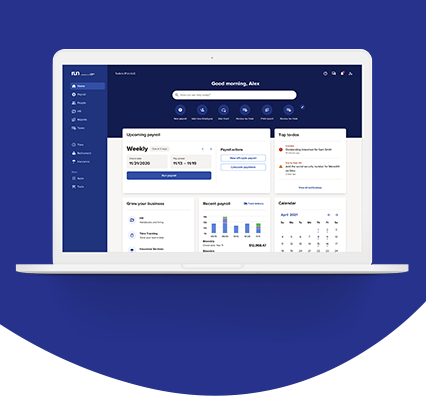Paying nannies and others who perform work in and around your home isn’t always a simple transaction. But having a household payroll service can help you comply with the household employee tax and other employer obligations.
Nanny payroll compliance
Depending on how much you pay your nannies or other household employees, you may have to withhold employment taxes from their wages. Failing to do so can result in an IRS audit, in which case, you might have to pay back taxes, along with interest and penalties.
Making payments “off the books” can also be detrimental to your employees. Without a tax record, they may not be able to build an employment history or access unemployment benefits in the event you no longer require their services.
To comply with household labor laws, you must pay your nanny largely how businesses compensate their employees:
Gather required paperwork
Track hours worked
Calculate and pay wages
File payroll taxes
What is the nanny tax?
The term “nanny tax” refers to the taxes that an employer must pay for a nanny – a type of “household employee,” or someone who performs work in and around other people’s homes. The IRS provides specific guidelines on how to determine who is subject to this tax. Among other criteria, an individual may be a household employee if you control both what work is done and how it’s done. Those who control how their work is done and provide their own tools and supplies are typically self-employed. Exemptions to household employee taxes sometimes apply if a nanny is your spouse, your parent, your child under age 21 or an employee under age 18.
Nanny tax withholding
If your nanny earns $2,700 or more per year, you may need to pay both Medicare tax and Social Security tax, collectively known as Federal Insurance Contribution Act (FICA) taxes. Typically, half of these taxes are paid by the employer and the other half are withheld from employee wages, but you have the option of paying both portions yourself.
Nanny unemployment tax
You may also be responsible for federal unemployment tax (FUTA) if you pay your nanny $1,000 or more in any one quarter. Contact your state unemployment insurance agency to determine whether FUTA, state unemployment tax or both are required.
Nanny income tax
The IRS generally doesn’t require you to withhold federal income tax from a household employee’s wages unless the employee requests it and you agree to it. In cases such as this, a Form W-4, Employee’s Withholding Certificate is used to determine the amount of federal income tax to withhold. If either you or your nanny decide to end your income tax withholding agreement, it usually must be done in writing.
State and local income tax may also apply. Check with government agencies in your area for specific withholding requirements.
Nanny payroll services and software
One of the best ways to avoid a compliance misstep when paying your nanny is to work with a payroll provider that’s capable of meeting household employer needs. Look for those who offer:
- Automatic payroll processing
Automation may reduce the time it takes to pay your nanny and minimize errors. - Tax withholding
Payroll providers usually can calculate and withhold the correct amount of taxes from your nanny’s wages and send it to government agencies. - Help managing state and federal compliance
Some payroll providers offer easy access to employment forms and may notify you about regulatory changes. - Employee self-service with mobile capability
Your nannies may be able to view their pay information anytime, anywhere. - Flexible pay options
You may have the option of paying your nanny via check, direct deposit or pay card. - 24/7 support
Get answers to questions about paying nannies when you need them most.
Nanny time tracker
Household employees are typically classified as non-exempt under the Fair Labor Standards Act (FLSA), which means they’re entitled to overtime. For this reason, you need a method of accurately tracking how many hours per week your nanny works. Many payroll providers are capable of integrating their software with time and attendance programs that automatically calculate the total hours worked, eliminating manual data entry and improving payroll accuracy.
How to set up nanny payroll
No matter how eager you and your nanny are to start working together, it’s best to have your payroll process in place first. Here are some basic steps to setting up household payroll:
- Verify which taxes apply to your nanny
- Apply for an employer identification number (EIN)
- Have your nanny complete the necessary employment documents
- Obtain workers’ compensation insurance
- File a new hire report with your designated state agency
Additional steps may be required. Employers are advised to consult IRS Publication 926 (Household Employer’s Tax Guide) and relevant state and local guidance.
Documents for nanny payroll
Some of the documents that are typically necessary to process nanny payroll include:
- Form W-2, Wage and Tax Statement
You must supply nannies with a Form W-2 by January 31 each year so they can file their taxes appropriately. If their wages were subject to FICA taxes or if you withheld income tax, you may also be required to provide a copy to the Social Security Administration. - Form W-3, Transmittal of Wage and Tax Statements
Send Form W-3 to the Social Security Administration to show them the total earnings on your nanny’s Form W-2. - Form W-4, Employee’s Withholding Certificate
If your nannies have requested that you deduct income tax from their pay, they should complete a Form W-4, detailing their filing status and withholding amounts. - Schedule H, (Form 1040), Household Employment Taxes
If you withheld income tax or paid your nanny cash wages that were subject to FICA or FUTA taxes, use Schedule H to report these totals to the IRS.
Nanny I-9 form
Any nannies you hire will also need to complete a Form I-9, which verifies that they can legally work in the United States. The paperwork must include evidence of their identity and employment eligibility via a passport, driver’s license or other official documentation as outlined on the form. Once the Form I-9 is complete, keep it on file in case an authorized U.S. government official asks to review it.
Nanny pay rate calculator
By estimating your nanny’s earnings, you’ll have a better idea of which taxes may apply. Use ADP’s gross wage calculator to see how much take home pay your nanny can earn before incurring FICA taxes. Note that as of 2020, you can pay your nanny up to $2,199 gross per year before you both may be responsible for FICA taxes.
Important Note on Calculator: The calculator on this page is provided through the ADP Employer Resource Center and is designed to provide general guidance and estimates. It should not be relied upon to calculate exact taxes, payroll or other financial data. These calculators are not intended to provide tax or legal advice and do not represent any ADP service or solution. You should refer to a professional advisor or accountant regarding any specific requirements or concerns.
Nanny payroll support
If you work with a payroll provider, they will usually help you set up your household payroll and support you thereafter. You may even access to experienced payroll specialists who can answer your questions about paying household employees. And in some cases, depending on the level of service you purchase, payroll providers will help you stay informed of any legal or regulatory changes that could affect you and your nanny.
Why choose ADP® for nanny payroll?
At ADP, we understand the needs of small business employers, even those who might not think of themselves as one. That’s why our small business payroll has built in capabilities for household payroll that can reduce the time it takes to pay nannies and others who work in or around your home. Best of all, our software is backed by experts who know the ins and outs of household employee taxes to help you avoid costly mistakes.
Nanny payroll FAQs
See what other household employers are asking about nanny payroll:
How much do nanny payroll services cost?
The cost of nanny payroll depends upon several factors, including the number of household employees you have, how often you pay them and which services you need. ADP will work with you to determine the right payroll setup for your household employment situation.
How much can you pay a nanny before taxes must be paid?
If you pay your nanny $2,700 or more per year, both you and the employee may be subject to FICA taxes on those wages. You might also have to pay FUTA taxes (and/or state unemployment taxes) if your nanny makes more than $1,000 in any quarter during the current year or previous year.
Is it ok to pay a nanny cash?
You can sometimes make cash payments to household employees if you follow federal and state regulations, document the amounts and properly withhold all necessary deductions. This might seem costly and time consuming for just one employee, but it can help prevent the added expense of tax penalties. Look to a payroll provider for assistance.
Can I treat my nanny as an independent contractor?
Because they perform work in or around your home and you control how the work is done, nannies are usually considered household employees, not independent contractors. One of the primary differences is that independent contractors typically have full control of how they do their work, while employees do not. Misclassifying a worker’s status, even if by mistake, may result in penalties.
What is the nanny law?
The “nanny law” or “nanny tax” is another way of referring to the household employee tax, which may apply to nannies and anyone else who works in your home. Within this regulation, the IRS outlines who is considered a household employee and how to determine if the individual’s wages are subject to taxes.
How can I pay my nanny?
To pay your nanny, you may need to apply for federal and state tax ID numbers, track your nanny’s hours, calculate payroll and taxes, and submit the proper forms (W-3, W-4, Schedule H etc.) to government agencies.
How do I create a Form W-2 for my nanny?
- Order the Form W-2 from the IRS website
- Complete the form following the instructions provided with it
- Verify the information and mail it to your nanny before January 31
- Send completed W-2 and W-3 forms to the Social Security Administration, if required
Is babysitter money taxable?
Babysitter income may be subject to household employee taxes if the yearly or quarterly earnings are more than the IRS wage base for FICA and FUTA. Exemptions sometimes apply if the babysitter is your spouse, your parent, your child under age 21 or anyone under age 18.
Can I use a dependent care FSA to pay for a nanny?
Flexible spending accounts can sometimes be used to offset dependent care spending. You typically still have to follow household employee tax guidelines though.
This guide is intended to be used as a starting point in analyzing an employer’s payroll obligations and is not a comprehensive resource of requirements. It offers practical information concerning the subject matter and is provided with the understanding that ADP is not rendering legal or tax advice or other professional services.


